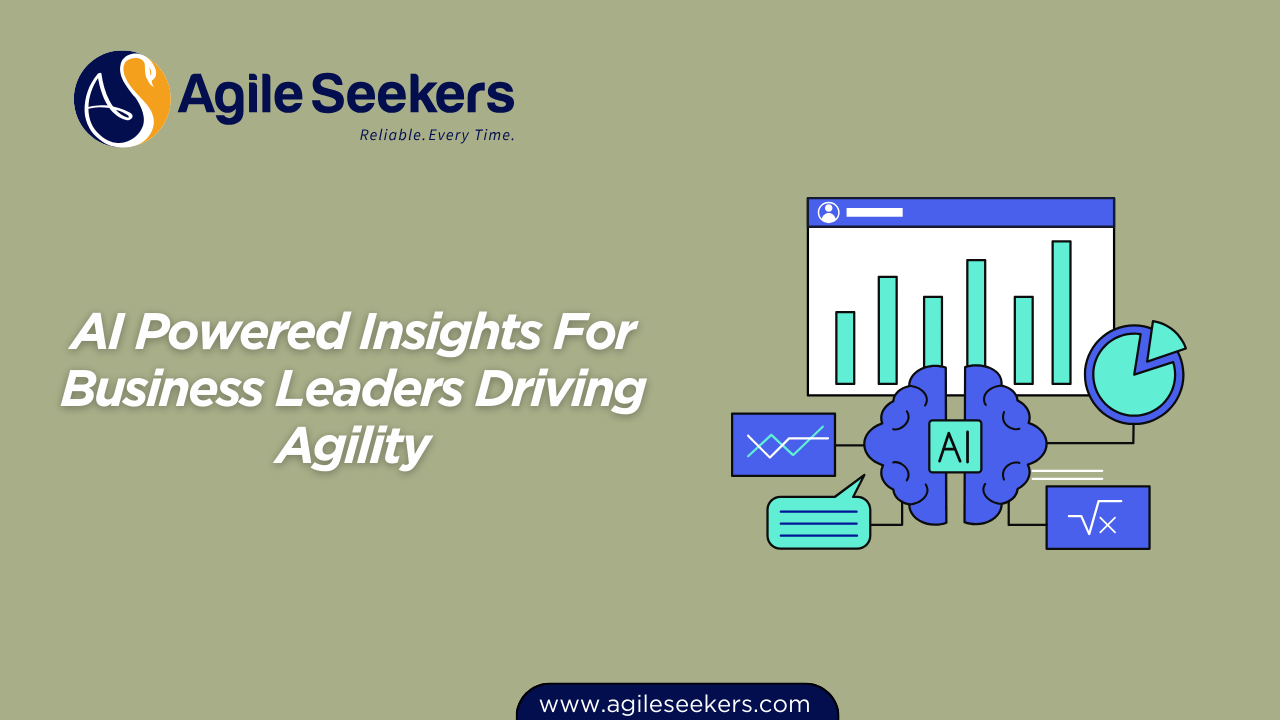AI Powered Insights For Business Leaders Driving Agility

Business leaders today are under constant pressure to make decisions that balance long-term strategy with short-term execution. The challenge isn’t just about speed; it’s about clarity. Data pours in from every corner of the enterprise—markets, teams, customers, and operations. What separates effective leaders from the rest is their ability to turn that data into actionable insights. This is where AI-powered insights step in, enabling leaders to drive agility at scale.
Why Leaders Need AI Insights for Agility
Agility is more than adopting Agile frameworks. It’s about building an adaptive organization that can sense change and respond quickly. Leaders face three barriers:
-
Information overload – Too much data, not enough clarity.
-
Bias in decision-making – Human judgment often leans on intuition instead of evidence.
-
Slow feedback loops – By the time insights surface, opportunities may already be lost.
AI closes these gaps by filtering noise, uncovering hidden patterns, and presenting leaders with real-time visibility. When leaders have the right insights at the right time, agility becomes more than a buzzword—it becomes a practical reality.
AI Insights Across the Leadership Agenda
1. Strategic Planning with Predictive Analytics
Traditional planning relies on historical performance and gut feel. AI flips this by running predictive models that highlight emerging trends and risks. For example, AI tools can forecast demand shifts, customer churn, or supply chain vulnerabilities. Leaders can then adapt strategies early, instead of reacting late.
(See: AI for Agile Leaders and Change Agents Certification for structured learning on using AI for leadership decisions.)
2. Portfolio Alignment and Prioritization
Enterprise portfolios are filled with competing initiatives. Without clarity, resources scatter, and agility suffers. AI-powered portfolio insights help leaders see which investments align most with business goals. Scenario simulations allow leaders to compare trade-offs—whether shifting funding, reassigning teams, or delaying features will yield better outcomes.
For project leaders, the AI for Project Managers Certification Training dives into practical tools for managing scope, dependencies, and risks with AI support.
3. Driving Transparency with Real-Time Dashboards
Transparency fuels trust across teams, but leaders often struggle with fragmented reports. AI integrates data from multiple systems into unified dashboards that refresh in real time. Instead of waiting for weekly updates, leaders can see live progress, blockers, and risks.
External case studies, like McKinsey’s research on AI and enterprise agility, show that organizations with AI-powered reporting outperform peers in adapting to market shifts.
4. Enhancing Customer-Centric Agility
Business agility depends on how quickly organizations respond to customer needs. AI insights from behavior analytics, sentiment tracking, and product usage patterns allow leaders to pivot strategies toward what delivers the most value.
This is especially relevant for product leaders. The AI for Product Owners Certification Training equips them to prioritize backlogs with customer insights, not assumptions.
5. Strengthening Execution with Intelligent Workflows
Execution falters when teams lack clarity on dependencies or waste time in manual processes. AI optimizes workflows by spotting inefficiencies, suggesting automation, and predicting delivery risks. Leaders can use these insights to keep teams aligned while reducing friction.
Scrum Masters play a critical role here. With AI for Scrum Masters Training, they learn how AI tools improve sprint planning, velocity tracking, and impediment removal.
How AI Builds Agility into Leadership Mindsets
Adopting AI insights is not just about tools—it’s about a shift in leadership mindset. Business leaders who embrace AI:
-
Rely on evidence over intuition – Reducing guesswork in decisions.
-
Act in shorter cycles – Using real-time data to test, learn, and adapt faster.
-
Balance strategy with execution – Seeing both big-picture outcomes and ground-level realities.
-
Empower teams – Sharing AI insights transparently so teams self-correct without waiting for directives.
This evolution transforms leaders from controllers into enablers of agility.
Practical Examples of AI Insights in Action
-
Risk Anticipation in Portfolios
AI models warn portfolio managers when initiatives show delivery risk—say, due to overloaded teams or shifting dependencies. Leaders can reallocate early rather than after delays hit. -
Customer Journey Optimization
Retail leaders use AI to track drop-off points in digital journeys. Insights allow them to redesign touchpoints that convert more customers, boosting agility in responding to buyer behavior. -
Resource Optimization in Operations
Manufacturing executives use AI to optimize production scheduling, cutting downtime and waste. Agility shows up not just in IT, but across the enterprise.
Challenges Leaders Must Navigate
AI adoption isn’t without obstacles. Leaders must deal with:
-
Data quality issues – Poor data equals poor insights.
-
Change resistance – Teams may resist trusting algorithms over experience.
-
Ethical considerations – Transparency in how AI reaches conclusions is vital.
Ethical adoption strategies are just as important as technical implementation. Studies from Harvard Business Review on responsible AI emphasize embedding accountability frameworks alongside AI insights.
Steps for Leaders to Start Using AI-Powered Insights
-
Audit decision-making gaps – Identify where slow, biased, or incomplete insights are blocking agility.
-
Pilot with clear use cases – Start with portfolio prioritization, customer feedback, or sprint reporting.
-
Upskill leadership teams – Certifications like those from AgileSeekers give leaders hands-on practice in applying AI to their roles.
-
Integrate with existing frameworks – AI should strengthen, not replace, Agile practices.
-
Build trust and transparency – Share insights openly, so teams understand decisions and stay aligned.
Final Thoughts
AI-powered insights aren’t just a technology upgrade—they’re a leadership advantage. They enable faster, smarter, and more transparent decision-making, which is the essence of business agility. Leaders who embrace AI don’t just react to change; they anticipate it, shape it, and guide their organizations through it.
With focused learning—whether through AI for Agile Leaders, AI for Project Managers, AI for Product Owners, or AI for Scrum Masters—leaders can move from exploring AI to embedding it at the heart of their organizations’ agility journey.
Also read - How AI Improves Collaboration Between Change Agents And Teams
Also see - The Importance Of AI Literacy For Portfolio And Program Managers




















